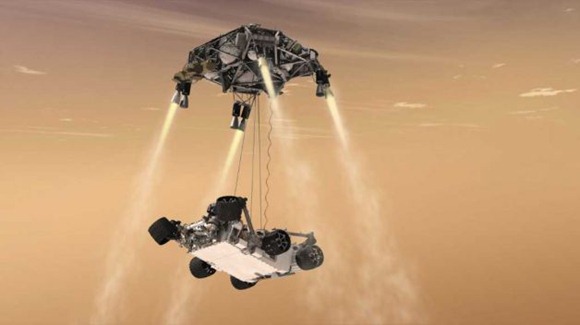Humans quest for exploring the surrounding planets to see whether we can live there or not is taking new shape today. NASA’s Mars probing robot, Curiosity, blasted off today on its 9 months journey to reach Mars and explore it for the possibilities of life there. Scientist says that Curiosity is one most advanced rover ever launched to probe life on other planets. Here is the launch video and some analysis by a news reporter
Lets look at the 6 interesting facts about the mission
1. It’s as big as a car
Curiosity is the biggest ever rover ever launched by NASA to probe life on outer planets. It’s as big as a car and almost double the size of its predecessor rover Spirit. The length of Curiosity is around 9 feet 10 inches(3 meters), width is 9 feet 1 inch (2.8 meters) and height is 7 feet (2.1 meters).

2. Powered by Plutonium – Lasts 24×7 for 23 months
The earlier missions of NASA to explore Mars are powered by Solar power and that hindered capabilities of the rovers to move around when the Sun is hiding. Due to dependency of Sun the earlier rovers were not able to traverse the places where there is no Sun light.
Curiosity on the other hand is equipped with a radioisotope power system that generates electricity from the heat emitted by plutonium’s radioactive decay. The plutonium weighs around 10 pounds and can generate power required for operating the rover close to 23 weeks. The best part of the new power system is, Curiosity can roam around in darkness, light and all year around.
3. Rocket powered backpack for a science fiction style landing
The Curiosity is so heavy that NASA could not use parachute and balloons to air-drop the rover on the surface of Mars like it’s previous missions. They are trying out a new science fiction style air-dropping mechanism that is similar to sky crane heavy-lift helicopter.
The landing of the rover begins first with entry into the Mars atmosphere protected by a heat shield. At about 6 miles to the surface, the heat shield is jettisoned and a parachute is deployed to glide the rover smoothly. When the rover touches 3 miles above the surface, the parachute is jettisoned and the eight motors rocket backpack is used for a smooth and impact free landing as shown in the image.

Here is an animation created by NASA on the landing sequence.
If you are interested in getting more detailed information about the landing process check this landing sequence picture available on NASA website
4. Equipped with Star Wars style laser gun
Hollywood movie directors and novelist always imagined aliens coming to earth with spaceships full of laser guns and blasting the objects which comes on their way. With Curiosity the equations are going to change. It has a powerful laser gun equipped in one of it’s arms to beam laser on rocks to vaporize them.
This is not part of any assault mission Curiosity is expected to carry out, the laser gun is will be used to carry out experiments to detect life and understand nature.
5. Most sophisticated laboratory powered by 10 instruments
Around 10 state of art instruments are part of Curiosity rover and the these 10 instruments form a most advanced rover based lab ever built by NASA. There are instruments to cut through rocks to examine them and other instruments will search for organic compounds. Mounted cameras can study targets from a distance, arm mounted instruments can study the targets they touch. Microscopic lens attached to the arm can see and magnify tiny objects as tiny as 12.5 micro meters.
6. Rover Carrying 1.24 million names etched on silicon
Early June 2009 NASA launched a campaign called “Send Your Name to Mars” and around 1.24 million people registered their names through NASA’s website. All those 1.24 million names are etched on Silicon chips mounted onto Curiosity’s deck. If you had registered your name in the campaign may be your name is going to reach Mars soon.
Curiosity On Web
If you wish to follow the mission here are few links to help you
- NASA’s Curiosity Web Page
- Follow Curiosity on Facebook
- Follow @MarsCuriosity on Twitter
- Artistic Gallery Image of Mars Rover Curiosity
- A printable sheet of Curiosity Mission [pdf]
Images credit: NASA
